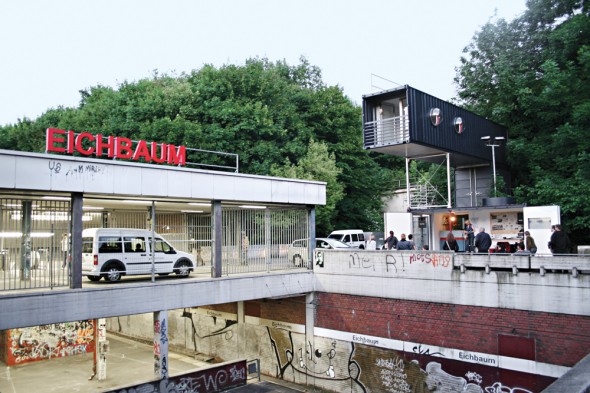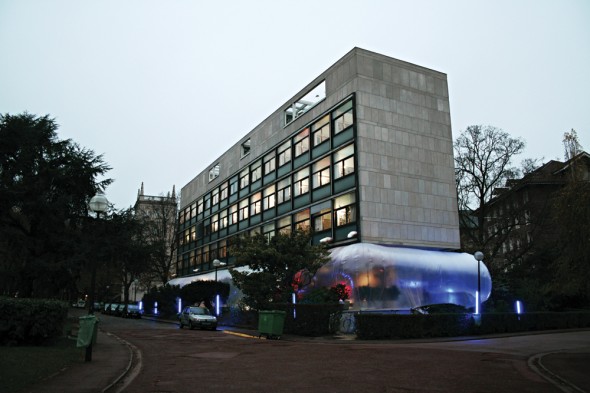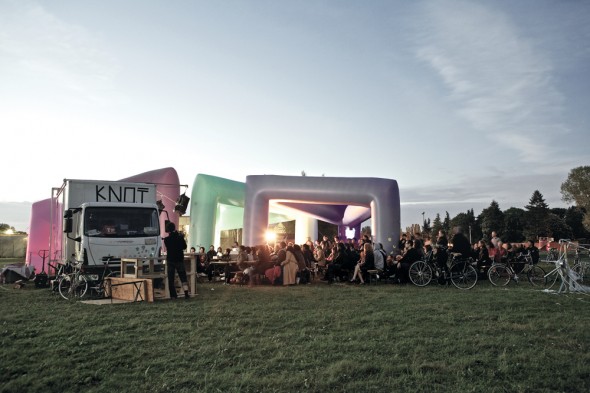We crowd our big cities and so they expand. Unbound and frontierless, new buildings, subdivisions and freeway infrastructures swell the urban landscape upward and outward. Meanwhile, as people flood the Metropolis, neighboring towns and smaller cities are drying out, losing population and in turn industry, culture, civic pride, character… Raumlabor, an architecture team based in Berlin, focuses on reviving these shrinking cities from the inside, innovating projects that recycle and revise what lies between the sidewalk cracks.
Raumlabor reclaims dead zones. Imagine an opera house installed in your city’s dingiest metro stop. Raumlabor did (“Eichbaumoper,” Mülheim, 2009). Consider dining in a bubble underneath a freeway overpass. Also done (“Das Küchenmonument,” various cities, various installations, 2006–present). By recovering forgotten or neglected spaces, Raumlabor tills rather than obliterates land, and focuses on unseen details to find new possibilities.
Though they could, Raumlabor’s eight architects never work alone or keep it all in house. Instead, they team up with locals, in a communal process that educates both sides and brings in new ideas. The result: smart, well-conceived and sustainable projects that respond directly to community needs and dreams.
Take the “Eichbaumoper”. Work began on the Eichbaum metro station in Mülheim, in 2007. When it was built in the 1970s, the Eichbaum stop represented an optimistic outlook, a brand new metro line that would connect two industrial hubs in the northwest: Essen and Mülheim. For a while, the station platform hosted a farmers’ market. By the time Raumlabor got started, the Eier-Omis had long since deserted, leaving a dismal and unsafe concrete block vulnerable to the unsavory.
Raumlabor collaborated with Eichbaum station neighbors, taking seriously the effect of this scarred and failed landscape. Within months, three local theater groups and tons of local volunteers were composing site-specific librettos and choreographing an opera. Simultaneous to all of this and several mini-projects (an inflatable room, workshops, site renovation, a graffiti wall), Raumlabor was working with a younger local population on an initiative to set the Eichbaum station up as a boxing ring (“Eichbaumboxer”). When it opened in July 2009, all objectives were met or were well underway. Though the opera ran just one summer, boxing matches and other events and workshops continue on site under the direction of local volunteers. Clearly, Raumlabor is effecting sustainable outcomes.
Sustainable need not mean permanent. Much of their work (like “Das Küchenmonument” which blows up for limited periods) is temporary and transportable, qualities that characterize Raumlabor’s philosophy that cities are flexible living organisms that, ideally, undergo constant change. Projects like “The Knot” (a mobile fair featuring concerts, community meals, artistic production and exhibitions) inject a landscape with culture and then leave on a high note, with a buzzing, energetic community ready to keep the ball rolling. With such ventures, Raumlabor seeks to model a community-built reality that does not compete with the neighboring, dominant capitalist city. This is especially true, since “The Knot” exists because of and for its neighbors—invited artists, educators and cooks are harvested locally. “The Knot” is also a traveling show and has visited Berlin, Warsaw and Bucharest since 2010. Literally tying a knot between international cities, the fair replaces political or capitalistic boundaries with cultural collectivity and shared experience.

Eichbaum metro station in Mülheim

Eichbaumoper, Mülheim, 2009
Raumlabor’s utopian bent extends past the underground. The group also keeps in touch with the highbrow world of architecture and the complicated, super hot field of urban planning via projects, installations or site interventions that turn the academic conference or well-polished exhibition sideways. In fall 2010, Raumlabor went viral at La Biennale di Venezia – Architettura with a DIY chair-building project. As part of their bigger initiative called “The Generator,” Raumlabor designed and prepared materials for Adirondack-like chairs, built on site and then carried around the fair and eventually home by Biennale-goers. More than just a fun souvenir, the chairs could be and were stacked together. Forts were built, childhood remembered—all in the context of a decidedly adult affair.
Other Raumlabor projects seem capable of provoking a similar, cut-loose effect on an Armani glasses kind of audience. To name a few… Celebrating its 75th anniversary, the Fondation Suisse in Paris invited Raumlabor to invent a temporary fix for its warm-weather-best terrace. For three November days, Le Corbusier’s straight and narrow deck was encased in a bubble (“Hovercraft-Lifting Modernism,” Paris, 2008). Attendees of Tuned City, a conference on sound and public space, laid back outside on a tremendous communal mattress, taking in the lectures through wireless headsets (“City Mattress-Die Stadtmatratze,” Berlin, 2008).
Berlin serves as both host and frequent testing ground for a lot of Raumlabor’s interventions. A place where artists and other creatives freely roam, it’s the perfect city for the team’s projects and space experiments. Professor Benjamin Foerster-Baldenius, an architect at Raumlabor, is effusive about their city: “Raumlabor is a result of the Berlin environment. Without the Berlin of the last 20 years—with all its freedoms, cheap rents, many artists—we wouldn’t be what we are and we wouldn’t be making what we make.” Though well-integrated into its avant-garde environs, Foerster-Baldenius describes a disconnect between official city planning and the goals of Raumlabor: “With everything coming out of city planning, we are absolutely of another opinion. Only Markus [Bader] works with the Internationale Bauausstellung (Germany’s official city planning organization)… maybe their work will get better that way.”
Many share this complaint, fearing that with city planners at the wheel, Berlin might lose its free-spirit to institutionalism. Consider, for example, the high rises awkwardly placed in Potsdamer Platz. In any event, Raumlabor has Berlin-specific projects already underway, charged with the standard, as in untamed and uncompromising, Raumlabor energy. “All of [our projects] excite us,” explains Foerster-Baldenius, “We don’t make projects that don’t.”
– Sara Blaylock
Forthcoming projects
“Eingegangen am…,” installation at Stasimuseum, Berlin (Summer 2011)
Furnishings for the In Transit 2011 theater festival at Haus der Kulturen der Welt, Berlin (June 15-18, 2011)
Der Balthasar Meteor, scenery for Roman einer Stadt by
Gesine Danckwart at Schauspiel Köln, Cologne (premieres October 7, 2011)
“The World Under Construction,” first pavilion for Der Großen Weltausstellung 2012, on the former site of Tempelhof Airport, Berlin (August/September 2011)

Hovercraft-Lifting Modernism, Paris, 2008

The Knot, Berlin, Warsaw and Bucharest, 2010

